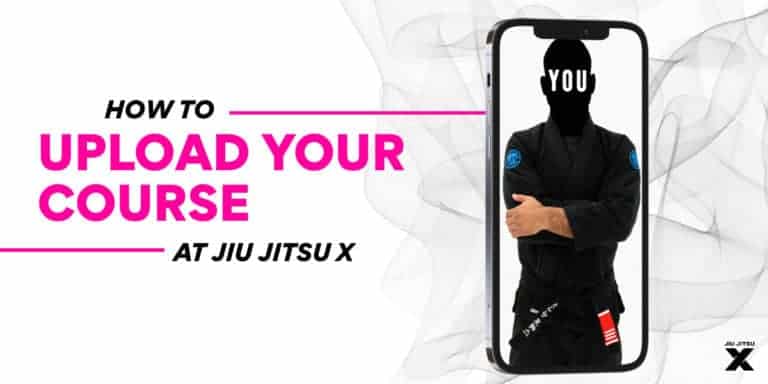
Learn how to pull guard safely and guarantee you start with the upper hand. Don’t go to training without reading this first!
Don’t you hate it when you pull guard, but your opponent quickly knocks your legs to the side and passes you anyway?
Have you ever pulled guard in competition only to see the referee award your opponent two points because they “controlled” your leg as you sat to the mat, scoring it a takedown on a technicality?
Whether you’re a brand new white belt or a veteran black belt who’s notorious for their guard, knowing how to pull guard safely is a skill you just have to have under your belt.
Most people think that getting a grip on their opponent’s collar, while placing a foot at their hip and falling to their butt is all they need to pull guard successfully.
The problem is, any jiu jitsu practitioner worth the color of their belt will see this lackadaisical approach coming from a mile off.
In fact, many competition teams around the world actually practice countering this movement by grabbing the leg as it comes to the hip and knocking it to the side for a snap pass, or using it to score those takedowns on a technicality as part of their warm-ups.
But the good news is, you don’t have to be cursed with an easily exploited weakness like this.
There is a way that you can safely pull guard that will ensure you never get passed during the movement that will also give you options to not only get your guard game going, but also bail out when things go wrong and even turn the tables with a quick takedown of your own.
And the best part is, the method waiting for you below works perfectly for all levels, white to black and beyond!
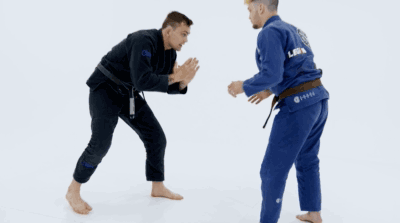
Begin with a staggard stance and reach with the rear hand to the cross side.
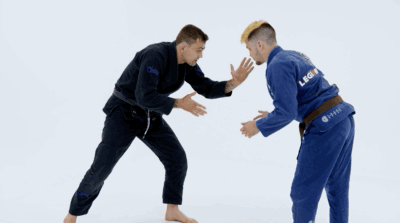
Reaching with the lead hand gives your opponent an easy target to deflect.
Once deflected, this opens up a huge gap between your arm and your lead leg and gives your opponent a huge opportunity to shoot for an unprotected single leg takedown
Next, let’s talk about whether or not you should bring your foot up to your opponent’s hip.
While you will see Andris doing this from time to time, it generally isn’t with the intention of pulling guard.
Rather, he will place the foot on the hip to initiate a tomoe nage (sweet ass judo throw) once his back touches the mat. If that fails, the second option is to pull guard.
However, if Andris’ primary goal is in fact pulling guard, placing the foot on the hip from a standing position won’t be the best way to do it.
Why?
Well, by doing this he is giving his opponent an option to grab his leg.
If the opponent is allowed to grip the leg, they can use this opportunity to push it to the side and pass as he sits to the mat, or use it to score one of those takedowns on a technicality we mentioned earlier.
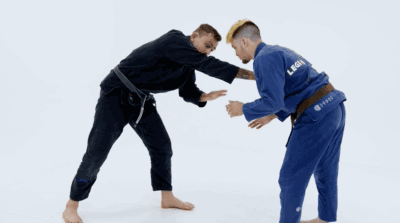
To pull guard safely, your next move is to sit on the mat quickly.
Specifically, sitting on the butt cheek opposite your gripping hand and posting on the mat with your free arm as support.
Note – your goal here is to sit straight down. Do not move toward your opponent in any way or pull them.
Pulling your oppoenent toward you or moving towards them in any way as you sit will give them an advantageous moment to hit a quick pass. Sit straight down and rob them of this opportunity.
Also, you don’t want to stay in this position for too long.
Don’t mistake this intermediary position between standing and pulling guard as something you can safely maintain for even a moderate period of time.
As your arm is stretched out, you are open to jumping triangles and armbars.
While these moves aren’t quite what you would call “high-percenters” if your opponent does attempt them, you may run the risk of a potential injury.
And even if they fail the submission attempt, they could land in a prime position to pass your guard.
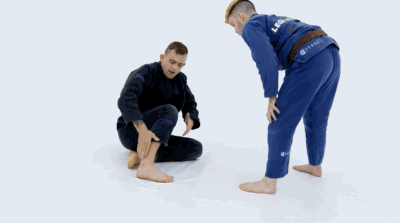
One of the key differences between pulling guard with the foot on the hip and pulling guard by sitting down, in the method above, is that by sitting down you give yourself options.
This is what Andris calls, peaking through the door.
That is, he’s not committing to anything without first getting a glimpse of the situation ahead.
Say you were successful in getting to your back with the foot on the hip method. Here, you have completely committed to playing guard, and while this might have been your goal all along, there is a chance your opponent may surprise you with their guard passing skills, their athleticism, or overwhelm you with their tenacity toward passing your guard.
This is why the sitting down method is much safer and superior when pulling guard, as it lets you see your opponent’s reactions first before committing and provides you with options to either abort the guard pull, by reverting back to a standing position or taking your opponent down with an easy ankle pick.
And one of the keys to opening these options up for you is keeping your legs at a right angle in the seated position.
Let’s look at that further…
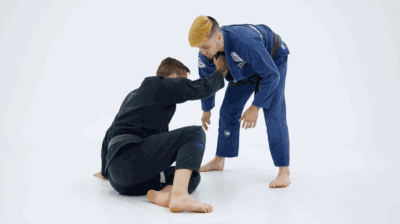
Notice how keeping your legs in this orientation allows for quick movements as your opponent circles around you and will also facilitate a snap return to the feet when needed.
And if you ever feel too threatened by your opponent in this position and want to readjust or get back to your feet for your contingency plan, all you need to do is post on the mat with your rear arm, elevate your hips and slide your knee behind you to initiate the technical get up.
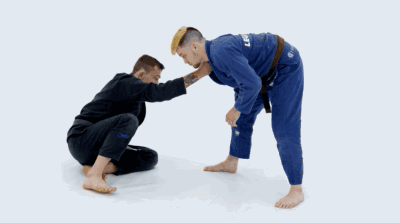
As mentioned earlier, one of the best things about Andris’ concept on how to pull guard is that you always have options.
If you see that your opponent is leading strongly with one leg, and by strongly I mean it’s within reach of your hands, this will be a great opportunity for getting on top with an ankle pick.
Furthermore, if your opponent has their leg close to you and is also pulling backward, in a reaction to the pull of your collar grip, scoring two points with this ankle pick will be even easier.
Again, like our previous tips, sitting on one butt cheek and orientating your legs at a right angle is absolutely crucial if you want to make this move work quickly and effortlessly.
From here, you’ll want to create a stiff push with your outstretched arm against your opponent’s chest as you sit up and place your rear foot behind your opponent’s leading heel.
This will help to stop or slow down their attempt to backstep to freedom before you can get your hand in place.
Once you’ve secured the position of your foot, reach behind your opponent’s heel and cup it with your free hand.
It is important to note that you don’t want to go too high with your grip, as doing so at the calf or behind the knee will allow your opponent to sprawl back and leave you in a vulnerable position.
Now, to hit the takedown you’ll need to create a counteraction between your arms as you pull your opponent’s heel towards you and punch their shoulder forward with your lapel grip.
Ensure you maintain your grips as you reach the top position, especially the grip on your opponent’s heel.
Maintaining control of the heel will take away their ability to quickly secure a guard of their own during the transition to their back and will give you the upper hand as you advance.
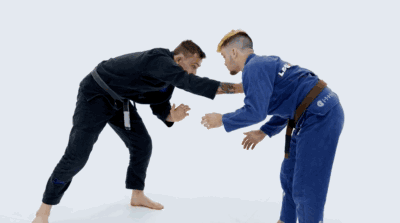
If after assessing the situation you feel it is in fact safe to pull guard, your first step is to retract your bottom leg so that you are posting upright on your bottom knee.
This new position will provide you with the perfect leverage to pull your opponent towards you as you shoot your bottom leg towards their hip.
Note – only start to pull your opponent as your leg travels towards their hip.
Doing so earlier will only pull your opponent on top of you without a frame to block the path of their chest towards your own.
From here, the pulling motion combined with your frame at the hip with your foot will often cause your oppoenent to hinge at the hip and brace against you with their hands to stop themselves from falling into your guard.
The key mechanics of this are a result of the contradicting forces of the pull with your hand and the push with your foot at the hip.
The hip is the major hinging joint of the body and the closest one down the chain from your pulling hand.
Framing here with your foot means your opponent cannot stop from bending over as you pull them towards you.
As they are forced to bend with forward momentum, their only option available is to brace on you with their hands.
This movement is in fact reflexive and ingrained into our nervous system as a protective measure.
A measure you can exploit to your advantage.
As they place their hands on you, you’ll find that more often than not you’ll be able to secure a sleeve and with that, and your already secured grip on the collar, you are all set to start your guard from the collar sleeve configuration.
There you have it, the safest way to pull guard without being passed. As you can see, the collar sleeve is the easiest and most efficient guard variation to move into when using the method above.
But we understand the collar sleeve may not be your best guard to play or at least it isn’t part of your A-game.
But that’s ok, because in Andris Brunovskis latest course, FLOW THEORY, you’ll learn how to transition from the collar sleeve to a wide variety of guards without the threat of being passed.
Be in control of your guard and ensure you never freeze or struggle to navigate to your A-game ever again with Andris Brunovksis latest course FLOW THEORY now!
Jiu Jitsu X is on a mission to make learning jiu jitsu online more pleasant and more effective. Transforming your knowledge on the mats.

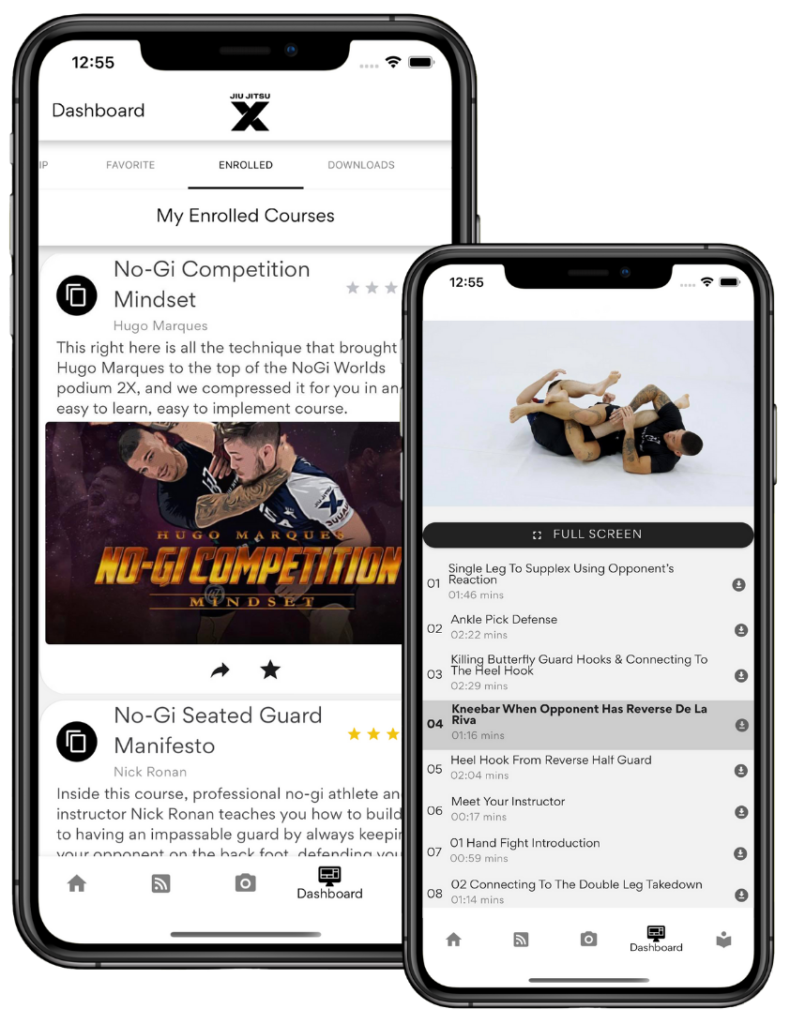
The BEST way to watch your courses and carry your favorite teachers in your pocket.
All you have to do is subscribe to our newsletter below and we’ll send your copy of the JJX Pressure Passing Cheatsheet straight to your inbox!
Plus, as a member of our newsletter list, you’ll also benefit from even more FREE game-changing content each week, plus handy alerts for all of our incredible discount sales.